

Compact Muon Solenoid
LHC, CERN
| CMS-EXO-16-027 ; CERN-EP-2016-216 | ||
| Search for high-mass diphoton resonances in proton-proton collisions at 13 TeV and combination with 8 TeV search | ||
| CMS Collaboration | ||
| 8 September 2016 | ||
| Phys. Lett. B 767 (2017) 147 | ||
| Abstract: The results of a search are presented for the resonant production of high-mass photon pairs, specifically spin-0 and spin-2 resonances with an invariant mass between 0.5 and 4.5 TeV, and with a width, relative to the mass, between $ 1.4 \times 10^{-4} $ and $ 5.6 \times 10^{-2} $. The data sample corresponds to an integrated luminosity of 12.9 fb$^{-1}$ of proton-proton collisions collected with the CMS detector in 2016 at a center-of-mass energy of 13 TeV. No significant excess is observed relative to the standard model expectation. The results of the search are combined statistically with those previously obtained in 2012 and 2015 at $\sqrt{s}=$ 8 and 13 TeV, respectively, corresponding to integrated luminosities of 19.7 and 3.3 fb$^{-1}$, to derive exclusion limits on scalar resonances produced through gluon-gluon fusion, and on Randall-Sundrum gravitons. The lower mass limits for Randall-Sundrum gravitons range from 1.95 to 4.45 TeV for coupling parameters between 0.01 and 0.2. These are the most stringent limits on Randall-Sundrum graviton production to date. | ||
| Links: e-print arXiv:1609.02507 [hep-ex] (PDF) ; CDS record ; inSPIRE record ; CADI line (restricted) ; | ||
| Figures | |

png pdf |
Figure 1:
The observed invariant mass spectra ${m_{\gamma \gamma }}$ for selected events in the (left) EBEB and (right) EBEE categories. There are no selected events with $ {m_{\gamma \gamma }} >$ 2000 GeV. The solid lines and the shaded bands show the results of likelihood fits to the data together with the associated 1 and 2 standard deviation uncertainty bands. The ratio of the difference between the data and the fit to the statistical uncertainty in the data is given in the lower plots. |
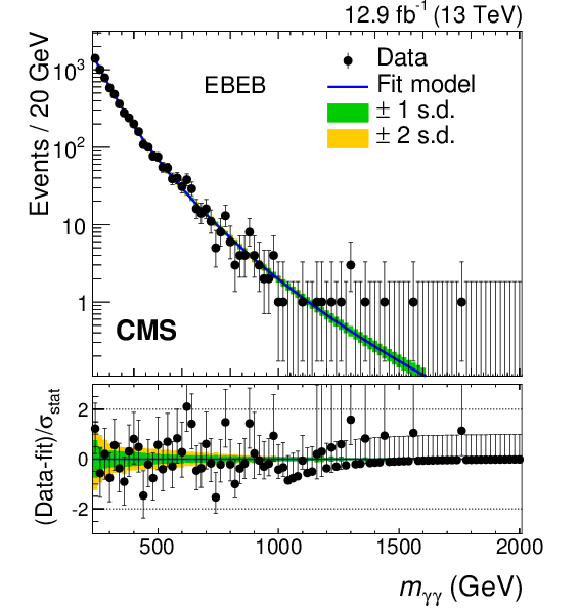
png pdf |
Figure 1-a:
The observed invariant mass spectra ${m_{\gamma \gamma }}$ for selected events in the EBEB category. There are no selected events with $ {m_{\gamma \gamma }} >$ 2000 GeV. The solid lines and the shaded bands show the results of likelihood fits to the data together with the associated 1 and 2 standard deviation uncertainty bands. The ratio of the difference between the data and the fit to the statistical uncertainty in the data is given in the lower plots. |

png pdf |
Figure 1-b:
The observed invariant mass spectra ${m_{\gamma \gamma }}$ for selected events in the EBEE category. There are no selected events with $ {m_{\gamma \gamma }} >$ 2000 GeV. The solid lines and the shaded bands show the results of likelihood fits to the data together with the associated 1 and 2 standard deviation uncertainty bands. The ratio of the difference between the data and the fit to the statistical uncertainty in the data is given in the lower plots. |
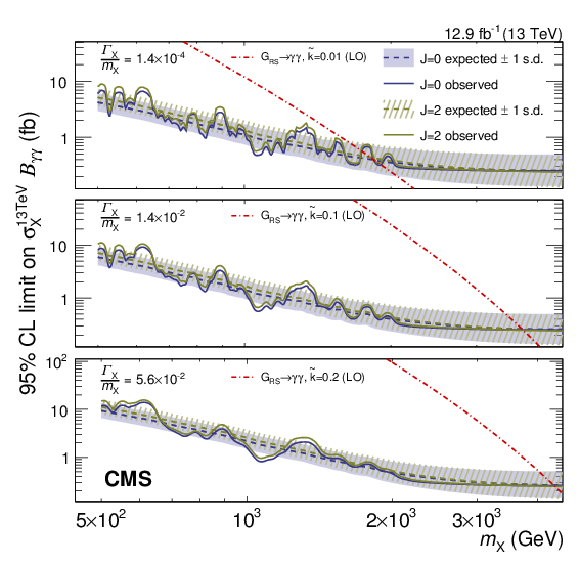
png pdf |
Figure 2:
The 95% CL upper limits on the production of diphoton resonances as a function of the resonance mass ${m_{\mathrm{X} }} $, from the analysis of data collected in 2016. Exclusion limits for the scalar and RS graviton signals are given by the grey (darker) and green (lighter) curves, respectively. The observed limits are shown by the solid lines, while the median expected limits are given by the dashed lines together with their associated 1 standard deviation uncertainty bands. The leading-order production cross section for diphoton resonances in the RS graviton model is shown for three values of the dimensionless coupling parameter $\tilde{k}$ together with the exclusion upper limits calculated for the corresponding three values of the width relative to the mass, ${\Gamma _{\mathrm{X} } / m_{\mathrm{X} }} $. Shown are the results for (upper) a narrow width, (middle) an intermediate-width, and (lower) a broad resonance. |
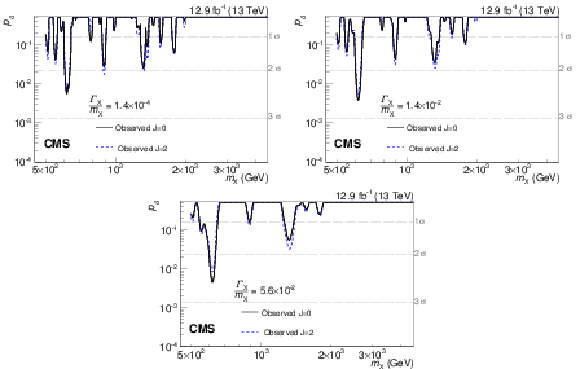
png pdf |
Figure 3:
Observed background-only $p$-values for resonances with (upper left ) $ {\Gamma _{\mathrm{X} } / m_{\mathrm{X} }} = 1.4\times 10^{-4}$, (upper right) $1.4\times 10^{-2}$, and (bottom) $5.6\times 10^{-2}$ as a function of the resonance mass ${m_{\mathrm{X} }} $, from the analysis of data collected in 2016. The solid black and dashed blue lines correspond to spin-0 and spin-2 resonances, respectively. |

png pdf |
Figure 3-a:
Observed background-only $p$-values for resonances with $ {\Gamma _{\mathrm{X} } / m_{\mathrm{X} }} = 1.4\times 10^{-4}$ as a function of the resonance mass ${m_{\mathrm{X} }} $, from the analysis of data collected in 2016. The solid black and dashed blue lines correspond to spin-0 and spin-2 resonances, respectively. |

png pdf |
Figure 3-b:
Observed background-only $p$-values for resonances with $1.4\times 10^{-2}$ as a function of the resonance mass ${m_{\mathrm{X} }} $, from the analysis of data collected in 2016. The solid black and dashed blue lines correspond to spin-0 and spin-2 resonances, respectively. |

png pdf |
Figure 3-c:
Observed background-only $p$-values for resonances with $5.6\times 10^{-2}$ as a function of the resonance mass ${m_{\mathrm{X} }} $, from the analysis of data collected in 2016. The solid black and dashed blue lines correspond to spin-0 and spin-2 resonances, respectively. |

png pdf |
Figure 4:
The 95% CL upper limits on the production of diphoton resonances as a function of the resonance mass ${m_{\mathrm{X} }} $, from the combined analysis of data collected in 2015 and in 2016. Exclusion limits for the scalar and RS graviton signals are given by the grey (darker) and green (lighter) curves, respectively. The observed limits are shown by the solid lines, while the median expected limits are given by the dashed lines together with their associated 1 standard deviation uncertainty bands. The leading-order production cross section for diphoton resonances in the RS graviton model is shown for three values of the dimensionless coupling parameter $\tilde{k}$ together with the exclusion upper limits calculated for the corresponding three values of the width relative to the mass, ${\Gamma _{\mathrm{X} } / m_{\mathrm{X} }} $. Shown are the results for (upper) a narrow width, (middle) an intermediate-width, and (lower) a broad resonance. |

png pdf |
Figure 5:
Observed background-only $p$-values for resonances with (upper) $ {\Gamma _{\mathrm{X} } / m_{\mathrm{X} }} = 1.4\times 10^{-4}$ and (lower) $5.6\times 10^{-2}$ as a function of the resonance mass ${m_{\mathrm{X} }} $, from the combined analysis of data recorded in 2015 and 2016. The results obtained for the two individual data sets are also shown. The curves corresponding to the scalar and RS graviton hypotheses are shown in left and right columns, respectively. The insets show an expanded region around $ {m_{\mathrm{X} }} =$ 750 GeV. |

png pdf |
Figure 5-a:
Observed background-only $p$-values for resonances with $ {\Gamma _{\mathrm{X} } / m_{\mathrm{X} }} = 1.4\times 10^{-4}$ as a function of the resonance mass ${m_{\mathrm{X} }} $, from the combined analysis of data recorded in 2015 and 2016. The results obtained for the two individual data sets are also shown. The curves corresponding to the scalar hypothesis is shown. The inset shows an expanded region around $ {m_{\mathrm{X} }} =$ 750 GeV. |

png pdf |
Figure 5-b:
Observed background-only $p$-values for resonances with $ {\Gamma _{\mathrm{X} } / m_{\mathrm{X} }} = 1.4\times 10^{-4}$ as a function of the resonance mass ${m_{\mathrm{X} }} $, from the combined analysis of data recorded in 2015 and 2016. The results obtained for the two individual data sets are also shown. The curves corresponding to the RS graviton hypothesis are shown. The inset shows an expanded region around $ {m_{\mathrm{X} }} =$ 750 GeV. |
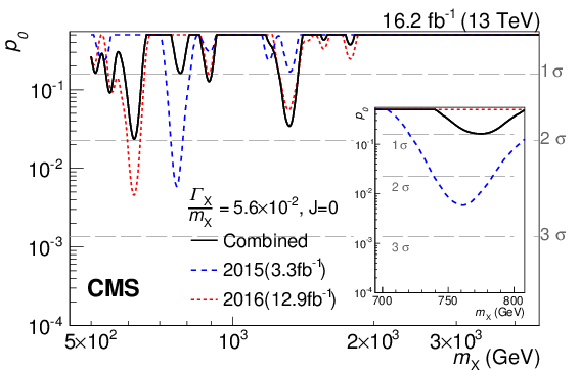
png pdf |
Figure 5-c:
Observed background-only $p$-values for resonances with $ {\Gamma _{\mathrm{X} } / m_{\mathrm{X} }} = 5.6\times 10^{-2}$ as a function of the resonance mass ${m_{\mathrm{X} }} $, from the combined analysis of data recorded in 2015 and 2016. The results obtained for the two individual data sets are also shown. The curves corresponding to the scalar hypothesis are shown. The inset shows an expanded region around $ {m_{\mathrm{X} }} =$ 750 GeV. |

png pdf |
Figure 5-d:
Observed background-only $p$-values for resonances with $ {\Gamma _{\mathrm{X} } / m_{\mathrm{X} }} = 5.6\times 10^{-2}$ as a function of the resonance mass ${m_{\mathrm{X} }} $, from the combined analysis of data recorded in 2015 and 2016. The results obtained for the two individual data sets are also shown. The curves corresponding to the RS graviton hypothesis are shown. The inset shows an expanded region around $ {m_{\mathrm{X} }} =$ 750 GeV. |
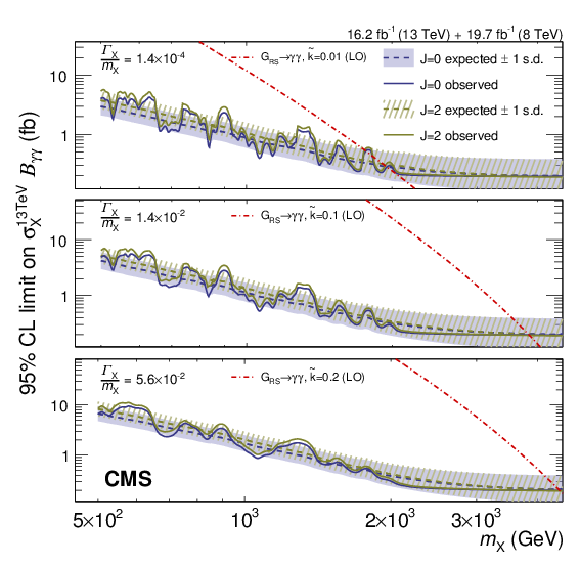
png pdf |
Figure 6:
The 95% CL upper limits on the production of diphoton resonances as a function of the resonance mass ${m_{\mathrm{X} }} $, from the combined analysis of the 8 and 13 TeV data. The 8 TeV results are scaled by the ratio of the 8 to 13 TeV cross sections. Exclusion limits for the scalar and RS graviton signals are given by the grey (darker) and green (lighter) curves, respectively. The observed limits are shown by the solid lines, while the median expected limits are given by the dashed lines together with their associated 1 standard deviation uncertainty bands. The leading-order production cross section for diphoton resonances in the RS graviton model is shown for three values of the dimensionless coupling parameter $\tilde{k}$ together with the exclusion upper limits calculated for the corresponding three values of the width relative to the mass, ${\Gamma _{\mathrm{X} } / m_{\mathrm{X} }} $. Shown are the results for (upper) a narrow width, (middle) an intermediate-width, and (lower) a broad resonance. |
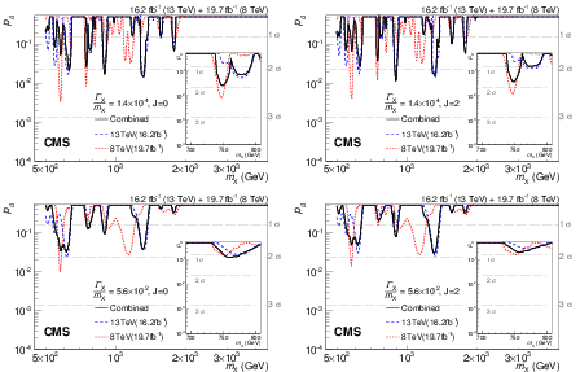
png pdf |
Figure 7:
Observed background-only $p$-values for resonances with (upper) $ {\Gamma _{\mathrm{X} } / m_{\mathrm{X} }} = 1.4\times 10^{-4}$ and (lower) $5.6\times 10^{-2}$ as a function of the resonance mass ${m_{\mathrm{X} }} $, from the combined analysis of the 8 and 13 TeV data. The results obtained for the two individual center-of-mass energies are also shown. The curves corresponding to the scalar and RS graviton hypotheses are shown in left and right columns, respectively. The insets show an expanded region around $ {m_{\mathrm{X} }} =$ 750 GeV. |
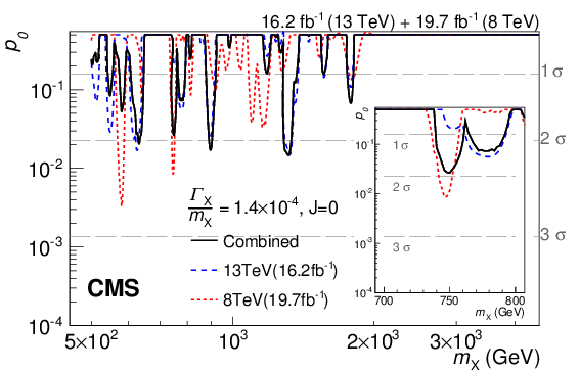
png pdf |
Figure 7-a:
Observed background-only $p$-values for resonances with $ {\Gamma _{\mathrm{X} } / m_{\mathrm{X} }} = 1.4\times 10^{-4}$ as a function of the resonance mass ${m_{\mathrm{X} }} $, from the combined analysis of the 8 and 13 TeV data. The results obtained for the two individual center-of-mass energies are also shown. The curves corresponding to the scalar hypothesis are shown. The inset shows an expanded region around $ {m_{\mathrm{X} }} =$ 750 GeV. |
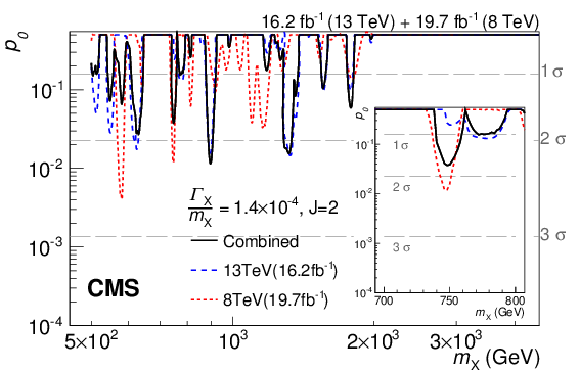
png pdf |
Figure 7-b:
Observed background-only $p$-values for resonances with $ {\Gamma _{\mathrm{X} } / m_{\mathrm{X} }} = 1.4\times 10^{-4}$ as a function of the resonance mass ${m_{\mathrm{X} }} $, from the combined analysis of the 8 and 13 TeV data. The results obtained for the two individual center-of-mass energies are also shown. The curves corresponding to the RS graviton hypothesis are shown. The inset shows an expanded region around $ {m_{\mathrm{X} }} =$ 750 GeV. |
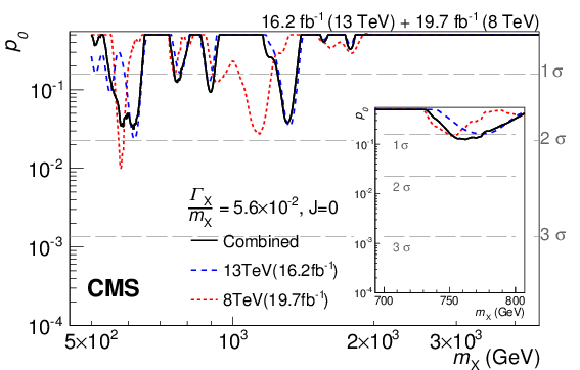
png pdf |
Figure 7-c:
Observed background-only $p$-values for resonances with $ {\Gamma _{\mathrm{X} } / m_{\mathrm{X} }} = 5.6\times 10^{-2}$ as a function of the resonance mass ${m_{\mathrm{X} }} $, from the combined analysis of the 8 and 13 TeV data. The results obtained for the two individual center-of-mass energies are also shown. The curves corresponding to the scalar hypothesis are shown. The inset shows an expanded region around $ {m_{\mathrm{X} }} =$ 750 GeV. |
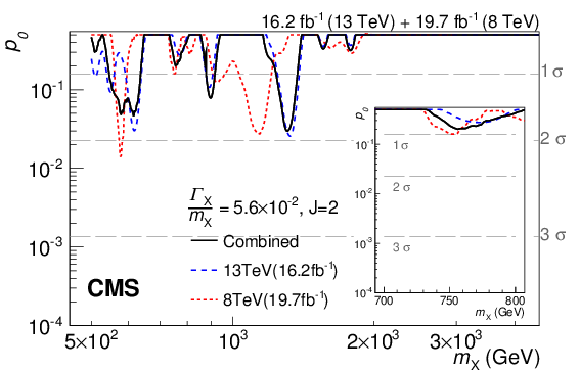
png pdf |
Figure 7-d:
Observed background-only $p$-values for resonances with $ {\Gamma _{\mathrm{X} } / m_{\mathrm{X} }} = 5.6\times 10^{-2}$ as a function of the resonance mass ${m_{\mathrm{X} }} $, from the combined analysis of the 8 and 13 TeV data. The results obtained for the two individual center-of-mass energies are also shown. The curves corresponding to the RS graviton hypothesis are shown. The inset shows an expanded region around $ {m_{\mathrm{X} }} =$ 750 GeV. |
| Summary |
| A search for the resonant production of high-mass photon pairs has been presented. The analysis is based on a sample of proton-proton collisions collected by the CMS experiment in 2016 at $\sqrt{s} =$ 13 TeV, corresponding to an integrated luminosity of 12.9 fb$^{-1}$. Events containing two photon candidates with transverse momenta above 75 GeV are selected. The diphoton mass spectrum above 500 GeV is examined for evidence of the production of high-mass spin-0 and spin-2 resonances. Limits on the production of scalar resonances and Randall-Sundrum gravitons in the range 0.5 $ < m_{\mathrm{X}} < $ 4.5 TeV and $ 1.4\times10^{-4}< \Gamma_{\mathrm{X}}/m_{\mathrm{X}} < 5.6\times10^{-2} $ are determined using the modified frequentist approach, where $m_{\mathrm{X}}$ and $\Gamma_{\mathrm{X}}$ are the resonance mass and width, respectively. The results obtained with the 2016 data set are combined statistically with those obtained in 2012 and 2015, corresponding to integrated luminosities of 19.7 and 3.3 fb$^{-1}$ of data recorded at $\sqrt{s} =$ 8 and 13 TeV, respectively. No significant excess is observed above the predictions of the standard model. Using the leading-order cross sections, Randall-Sundrum gravitons with masses below 3.85 and 4.45 TeV are excluded for values of the dimensionless coupling parameter $\tilde{k}=$ 0.1 and 0.2, respectively. For $\tilde{k}=$ 0.01, graviton masses below 1.95 TeV are excluded, except for the region between 1.75 and 1.85 TeV. These are the most stringent limits on Randall-Sundrum graviton production to date. |
| References | ||||
| 1 | N. Sakai | Naturalness in supersymmetric GUTS | Z. Phys. C 11 (1981) 153 | |
| 2 | ATLAS, CMS Collaboration | Combined Measurement of the Higgs Boson Mass in $ pp $ Collisions at $ \sqrt{s}= $ 7 and 8 TeV with the ATLAS and CMS Experiments | PRL 114 (2015) 191803 | 1503.07589 |
| 3 | L. Randall and R. Sundrum | A large mass hierarchy from a small extra dimension | PRL 83 (1999) 3370 | hep-ph/9905221 |
| 4 | G. C. Branco et al. | Theory and phenomenology of two-Higgs-doublet models | Phys. Rep. 516 (2012) 1 | 1106.0034 |
| 5 | L. Randall and R. Sundrum | An alternative to compactification | PRL 83 (1999) 4690 | hep-th/9906064 |
| 6 | N. Craig, J. Galloway, and S. Thomas | Searching for signs of the second Higgs doublet | 1305.2424 | |
| 7 | P. S. Bhupal Dev and A. Pilaftsis | Maximally symmetric two Higgs doublet model with natural standard model alignment | JHEP 12 (2014) 024 | 1408.3405 |
| 8 | L. D. Landau | On the angular momentum of a system of two photons | Dokl. Akad. Nauk SSSR 60 (1948) 207 | |
| 9 | C. N. Yang | Selection rules for the dematerialization of a particle into two photons | PR77 (1950) 242 | |
| 10 | ATLAS Collaboration | Search for resonances in diphoton events at $ \sqrt{s} = $ 13 TeV with the ATLAS detector | JHEP 09 (2016) 001 | 1606.03833 |
| 11 | CMS Collaboration | Search for resonant production of high-mass photon pairs in proton-proton collisions at $ \sqrt{s}= $ 8 and 13 TeV | PRL 117 (2016) 051802 | CMS-EXO-16-018 1606.04093 |
| 12 | CMS Collaboration | Search for diphoton resonances in the mass range from 150 to 850 GeV in pp collisions at $ \sqrt{s} = $ 8 TeV | PLB 750 (2015) 494 | CMS-HIG-14-006 1506.02301 |
| 13 | ATLAS Collaboration | Search for high-mass diphoton resonances in pp collisions at $ \sqrt{s} = $ 8 TeV with the ATLAS detector | PRD 92 (2015) 032004 | 1504.05511 |
| 14 | ATLAS Collaboration | Search for extra dimensions in diphoton events using proton-proton collisions recorded at $ \sqrt{s} = $ 7 TeV with the ATLAS detector at the LHC | New J. Phys. 15 (2013) 043007 | 1210.8389 |
| 15 | ATLAS Collaboration | Search for high-mass dilepton resonances in pp collisions at $ \sqrt{s} = $ 8 TeV with the ATLAS detector | PRD 90 (2014) 052005 | 1405.4123 |
| 16 | ATLAS Collaboration | Search for dilepton resonances in pp collisions at $ \sqrt{s} = $ 7 TeV with the ATLAS detector | PRL 107 (2011) 272002 | 1108.1582 |
| 17 | ATLAS Collaboration | Search for new phenomena in the $ W W $ to $ \ell \nu \ell{\rm'} \nu{\rm'} $ final state in pp collisions at $ \sqrt{s} = $ 7 TeV with the ATLAS detector | PLB 718 (2013) 860 | 1208.2880 |
| 18 | ATLAS Collaboration | Search for resonant diboson production in the $ WW/WZ \to \ell \nu j j $ decay channels with the ATLAS detector at $ \sqrt{s} = $ 7 TeV | PRD 87 (2013) 112006 | 1305.0125 |
| 19 | CMS Collaboration | Search for signatures of extra dimensions in the diphoton mass spectrum at the Large Hadron Collider | PRL 108 (2012) 111801 | CMS-EXO-11-038 1112.0688 |
| 20 | CMS Collaboration | Search for physics beyond the standard model in dilepton mass spectra in proton-proton collisions at $ \sqrt{s} = $ 8 TeV | JHEP 04 (2015) 025 | CMS-EXO-12-061 1412.6302 |
| 21 | CMS Collaboration | Search for heavy narrow dilepton resonances in pp collisions at $ \sqrt{s} = $ 7 TeV and $ \sqrt{s} = $ 8 TeV | PLB 720 (2013) 63 | CMS-EXO-12-015 1212.6175 |
| 22 | CMS Collaboration | Search for narrow resonances decaying to dijets in proton-proton collisions at $ \sqrt{s} = $ 13 TeV | PRL 116 (2016) 071801 | CMS-EXO-15-001 1512.01224 |
| 23 | CMS Collaboration | Search for narrow resonances using the dijet mass spectrum in pp collisions at $ \sqrt{s} = $ 8 TeV | PRD 87 (2013) 114015 | CMS-EXO-12-016 1302.4794 |
| 24 | CMS Collaboration | Search for narrow resonances in dijet final states at $ \sqrt{s}= $ 8 TeV with the novel CMS technique of data scouting | PRL 117 (2016) 031802 | CMS-EXO-14-005 1604.08907 |
| 25 | CMS Collaboration | Search for resonances and quantum black holes using dijet mass spectra in proton-proton collisions at $ \sqrt{s} = $ 8 TeV | PRD 91 (2015) 052009 | CMS-EXO-12-059 1501.04198 |
| 26 | CMS Collaboration | Search for massive resonances in dijet systems containing jets tagged as W or Z boson decays in pp collisions at $ \sqrt{s} = $ 8 TeV | JHEP 08 (2014) 173 | CMS-EXO-12-024 1405.1994 |
| 27 | CMS Collaboration | Search for exotic resonances decaying into $ \mathrm{ W }\mathrm{ Z }/\mathrm{ Z }\mathrm{ Z } $ in pp collisions at $ \sqrt{s} = $ 7 TeV | JHEP 02 (2013) 036 | CMS-EXO-12-014 1211.5779 |
| 28 | CMS Collaboration | Search for a narrow spin-2 resonance decaying to a pair of Z vector bosons in the semileptonic final state | PLB 718 (2013) 1208 | CMS-EXO-11-102 1209.3807 |
| 29 | ATLAS Collaboration | Search for Scalar Diphoton Resonances in the Mass Range 65--600 GeV with the ATLAS Detector in pp Collision Data at $ \sqrt{s} = $ 8 TeV | PRL 113 (2014) 171801 | 1407.6583 |
| 30 | CMS Collaboration | The CMS experiment at the CERN LHC | JINST 3 (2008) S08004 | CMS-00-001 |
| 31 | CMS Collaboration | Performance of photon reconstruction and identification with the CMS detector in proton-proton collisions at $ \sqrt{s} = $ 8 TeV | JINST 10 (2015) P08010 | CMS-EGM-14-001 1502.02702 |
| 32 | CMS Collaboration | Particle-flow event reconstruction in CMS and performance for jets, taus, and $ E_{\mathrm{T}}^{\text{miss}} $ | CMS-PAS-PFT-09-001 | |
| 33 | CMS Collaboration | Commissioning of the particle-flow event with the first LHC collisions recorded in the CMS detector | CMS-PAS-PFT-10-001 | |
| 34 | T. Sjostrand et al. | An Introduction to PYTHIA 8.2 | CPC 191 (2015) 159 | 1410.3012 |
| 35 | NNPDF Collaboration | Parton distributions with LHC data | NPB 867 (2013) 244 | 1207.1303 |
| 36 | H. Davoudiasl, J. L. Hewett, and T. G. Rizzo | Phenomenology of the Randall-Sundrum Gauge Hierarchy Model | PRL 84 (2000) 2080 | hep-ph/9909255 |
| 37 | T. Gleisberg et al. | Event generation with SHERPA 1.1 | JHEP 02 (2009) 007 | 0811.4622 |
| 38 | J. Alwall et al. | The automated computation of tree-level and next-to-leading order differential cross sections, and their matching to parton shower simulations | JHEP 07 (2014) 079 | 1405.0301 |
| 39 | H.-L. Lai et al. | New parton distributions for collider physics | PRD 82 (2010) 074024 | 1007.2241 |
| 40 | NNPDF Collaboration | Parton distributions for the LHC Run II | JHEP 04 (2015) 040 | 1410.8849 |
| 41 | CMS Collaboration | Event generator tunes obtained from underlying event and multiparton scattering measurements | EPJC 76 (2016) 155 | CMS-GEN-14-001 1512.00815 |
| 42 | \GEANTfour Collaboration | $ Geant 4 $ --- a simulation toolkit | NIMA 506 (2003) 250 | |
| 43 | CMS Collaboration | Observation of the diphoton decay of the Higgs boson and measurement of its properties | EPJC 74 (2014) 3076 | CMS-HIG-13-001 1407.0558 |
| 44 | CMS Collaboration | Measurement of differential cross sections for the production of a pair of isolated photons in pp collisions at $ \sqrt{s} = $ 7 TeV | EPJC 74 (2014) 3129 | CMS-SMP-13-001 1405.7225 |
| 45 | T. Junk | Confidence level computation for combining searches with small statistics | NIMA 434 (1999) 435 | hep-ex/9902006 |
| 46 | A. L. Read | Presentation of search results: the $ \rm CL_s $ technique | JPG 28 (2002) 2693 | |
| 47 | LHC Higgs Combination Group | Procedure for the LHC Higgs boson search combination in Summer 2011 | CMS-NOTE-2011-005 | |
| 48 | G. Cowan, K. Cranmer, E. Gross, and O. Vitells | Asymptotic formulae for likelihood-based tests of new physics | EPJC 71 (2011) 1554 | 1007.1727 |
| 49 | CMS Collaboration | CMS Luminosity Measurement for the 2015 Data Taking Period | CMS-PAS-LUM-15-001 | CMS-PAS-LUM-15-001 |
| 50 | A. D. Martin, W. J. Stirling, R. S. Thorne, and G. Watt | Parton distributions for the LHC | EPJC 63 (2009) 189 | 0901.0002 |

|
Compact Muon Solenoid LHC, CERN |

|

|

|

|

|

|